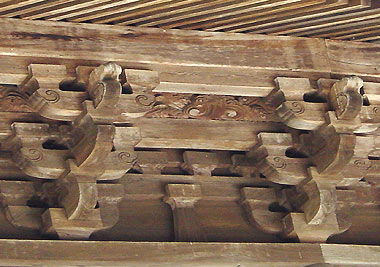|
||
 |
||

Kenchouji
Hattou 建長寺法堂 (Kanagawa)
(C)2001 Japanese Architecture and Art Net Users System. No reproduction or republication without written permission.
掲載のテキスト・写真・イラストなど、全てのコンテンツの無断複製・転載を禁じます。
|
||||||
| futatesakigumi 二手先組 | ||||||
| KEY WORD : architecture / general terms | ||||||
| Also called futatesaki tokyou 二手先斗きょう or futatesaki kumimono 二手先組物. A bracket complex composed of two steps. The first step *degumi 出組, is separated from the wall and carries the end of a rainbow beam *kouryou 虹梁, extended out from the interior at right angle to the wall. This beam end functions like a bracket arm *hijiki 肘木. At its outermost end it supports a small bearing block *makito 巻斗, into which another bracket arm carrying three bearing blocks is inserted. This combination is called *mitsudo tokyou 三斗斗きょう and it runs parallel to the wall plane. This is the second step. It often supports a purlin-bearing bracket arm *sanehijiki 実肘木, or a purlin *keta 桁. This is the simplest type of two-stepped bracket complex. Later, it became more complicated with the addition of tail rafters *odaruki 尾垂木, short curved transitional members set between beams at different levels *shirin 支輪, and a narrow latticed ceiling positioned beneath the eaves *nokitenjou 軒天井. One example in the *wayou 和様 style with tail rafters and is found at Kitano Tenmanguu 北野天満宮 (late 16c - early 17c) in Kyoto. | ||||||
 Kenchouji
Hattou 建長寺法堂 (Kanagawa)
|
||||||
| REFERENCES: | ||||||
| EXTERNAL LINKS: | ||||||
| NOTES: | ||||||
(C)2001 Japanese Architecture and Art Net Users System. No reproduction or republication without written permission. 掲載のテキスト・写真・イラストなど、全てのコンテンツの無断複製・転載を禁じます。 |
||||||